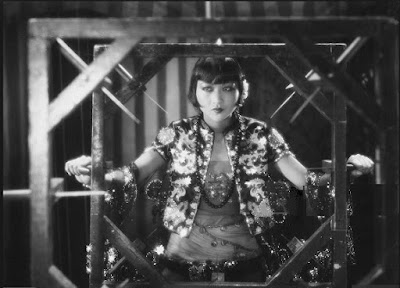Tonight, Kevin Brownlow had promised us a surprise from
his own collection and he delivered with a 16mm transfer of She’s a Sheik that
hasn’t been projected in public since I was in short pants (no, even earlier
than that troublesome New Romantic period…). The film had been transferred by a
British collector using ex-air force equipment and yet looked pretty fine
partly due to the extensive repair work of the Bioscope’s ace projectionist
Dave Locke.
Kevin described it as madcap like Hellzapoppin and whilst it doesn’t quite match the madness of that
film it’s heart-warmingly daft with a welcome eye on gender-reversal that suits
Bebe Daniel’s natural intelligence as well as William Powell’s willingness to
never take himself that seriously. It’s a little patchy in parts but redeemed
by Daniel’s making like Fairbanks as well as her old sparing partner Gloria
and, of course, Mr Valentino. No one can
pet a peacock (not going there…) wearing an outrageous feathered head-dress
quite like Bebe and she out smoulders Rudolph whilst lazily stroking a leopard which
is clearly benefiting from the same kind of head doctor as the Happy Mondays in
1991.
 |
| William Powell is about to get his thawb handed to him |
Bebe is a magnetic presence and a natural comedienne as
she would show from the Mack Sennett days through to the wise-cracking
screwballs of the thirties and beyond after she settled in the UK as Mrs Lyons
(not Leopard you may note…). She has a striking, thoroughly-modern face and yet
there’s always a twinkle… not so far from either Doug or Rudy then: these
people had The Glamour alright.
So does William Powell and Richard Arlen for that matter,
even when their characters are being humiliated by the film’s star. Bebe plays Zaida
a good catholic Spanish girl who is the adopted daughter of Sheik Yusif ben
Hamad (Paul McAllister … not many of us Paul’s get to be a Sheik!). The Sheik
is fully supportive of her right to choose a marriage partner and very quickly
she spies just the man, a French army officer, Captain Colton (Arlen), the
trouble is he’s already seeing a blonde Wanda Fowler (Josephine Dunn) who Zaida
spies two-timing him.
Reversing the, actually quite disturbing, kidnapping
approach to courtship from other films about similar things, Zaida takes her
Captain prisoner and quickly wins him over through basic womanly wiles and the
offer of food, drink and a good pipe. But it’s at this point that the nasty
Kada (Mr Powell) decides he’s going to take this woman himself and overcome the
French forces… What do you reckon to his chances of either?
 |
| Dreamy duo: Richard Arlen and Bebe Daniels |
Meg Morley accompanied having not even seen the film
before and provided some luscious chords with period-jazz flavours, sweeping
minor shapes that swept through the sand and patient, confident themes that
embraced the unpredictability of the action and the unseen narrative.
Lilian Henley provided similar service for the first film
with her own trademark polish and assurance. If Meg’s improvisational jazz
background informs her approach perhaps Lillian’s experience as a professional
actress informs her own highly-disciplined and sympathetic playing. I watched
Ben Travers flapper farce Thark last
week and it’s so close to Miss Bluebeard
in style and I’m taking a wild guess here, I could easily imagine it’s one of
Lillian’s favourite periods?
The film is not as zany as SAS and creakily shows its
stage roots having been based on a play, Little Miss Bluebeard, by Avery
Hopwood but does have its moments and some amazing costumery especially for
Bebe to wear.
The plot is as convoluted as all get out and shows once
again that you should never let anyone impersonate you as you can end up
married or even in court (name that Colleen Moore film!). But successful
composer Larry Charters (Robert Frazer) who is visiting Paris is so fed up of
young women chasing him that he asks his mate Bob Hawley (Kenneth MacKenna) to
impersonate him so he can focus on his writing.
He runs into stage actress Colette (see what they did
there…) who is introduced in one of the film’s cleverest moments behaving on
stage as we expect her character to behave in the film… and, one thing leads to
another and a drunken mayor marries them (dontcha just hate it when that
happens!).
So far, so what you may say but when Colette meets the
real Larry it is, ow you say, l’amour at first sight (Colette has title card
French to die for, n’est pas).
 |
| Robert Frazer, Martha O'Dwyer and Raymond Griffith |
Two sides to Bebe Daniels and proof that she could more
than match anyone for comedy, swinging action and romance. Plus... Swanson and the lion? Yeah, got me a leopard.
Before Bebe we had a Christmas short, a British version
of The Little Match Girl (1914) which
was indeed short and bitter sweet with Meg accompanying.
This was all a fine way to finish off the year at the
Bioscope. Here’s to 2018 and The Cinema Museum continuing to support this
excellent enterprise.
 |
| You're twisting my leopard man... |










































%20Despair.png)








